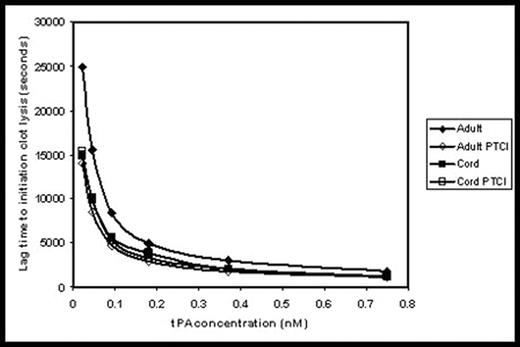Abstract
INTRODUCTION: Differences in both quantitative and qualitative components of the fibrinolytic system in newborns are well described. The overall impact of these variations in components on actual fibrinolytic capacity in response to various concentrations of tPA has not been assessed. There were two objectives for the current study,
To determine the relative clot lysis capacity of the newborn compared to the adult at various rt-PA levels.
To determine the effect of endogenous thrombin activated fibrinolytic inhibitor (TAFIa) on clot lysis in newborns compared to adults.
METHODS: Plasma from 20 normal adults and 20 normal cords were pooled. Plasma, 2.5 pM tissue factor, 5mM CaCl2 and 8 concentrations of rt-PA ranging from physiologic levels (0.02nM) to therapeutic levels (3.0 nM) was added to microtitre plates. Plates were sealed and clot turbidity was monitored at 405nm using a SpectraMax Platereader (Molecular Devices, USA) at 37°C over 72 hours. The following parameters of clot lysis were calculated:
lag time to clot lysis initiation (lag time),
slope/maximum absorbance-minimum absorbance correcting for differences in fibrin clot formed (slope),
time at which clot turbidity equals one-half of the full-scale value (t 1/2) and iv) end of clot lysis (end time).
In some experiments, potato tuber carboxypeptidase inhibitor (PTCI) a specific inhibitor of TAFIa, was added to plasma.
RESULTS: Comparison of newborn to adult: for clarity only 2 concentrations of r-tPA are shown (Table I). At therapeutic concentrations of rt-PA (3.0 nM) newborns were comparable to adults on all parameters of clot lysis. In contrast, at physiologic concentrations of rt-PA (0.023nM) when compared to adults, newborns demonstrated
decreased lag time
more rapid completion of clot lysis
more rapid t1/2 clot lysis
increased slope of clot lysis.
Effect of endogenous TAFI activity: Inhibition of TAFIa had no effect on the slope of lysis in either adult or newborn (data not shown). However, there was a large effect on decreasing lag time to lysis initiation in adults but little effect in newborns (Figure I). The lag time was comparable in adults with PTCI and to newborns. These data show that TAFIa activity has little effect on inhibiting fibrinolysis in newborns.
CONCLUSIONS: The concentration of rt-PA has a profound effect on the relative clot lysis in newborns compared to adults. At physiologic rt-PA concentrations the newborn initiates and completes clot lysis earlier and lyses clots at a faster rate than adults. Therefore, the newborn appears hyperfibrinolytic as compared to the adult at endogenous rt-PA concentrations. The hyperfibrinolytic response in the newborn can be explained, in part, by low apparent TAFIa concentrations. In contrast, at therapeutic rt-PA concentrations newborn clot lysis is comparable to the adult.
Comparision of clot lysis in newborn and adult plasma
| . | . | Lag time . | t 1/2 . | Slope . | Completion . |
|---|---|---|---|---|---|
| ** p<0.0001 when compared to adult | |||||
| 0.023nM tPA | Adult | 24,881±3628 | 74,267±6394 | 1.6±0.5 | 127,441±13,958 |
| Newborn | 11,971±2148** | 27,469±3413** | 3.6±0.7** | 39,505±3,408** | |
| 3.0 nM tPA | Adult | 496±92 | 709±39 | 203±17 | 839±106 |
| Newborn | 577±47 | 734±44 | 228±26 | 900±42 | |
| . | . | Lag time . | t 1/2 . | Slope . | Completion . |
|---|---|---|---|---|---|
| ** p<0.0001 when compared to adult | |||||
| 0.023nM tPA | Adult | 24,881±3628 | 74,267±6394 | 1.6±0.5 | 127,441±13,958 |
| Newborn | 11,971±2148** | 27,469±3413** | 3.6±0.7** | 39,505±3,408** | |
| 3.0 nM tPA | Adult | 496±92 | 709±39 | 203±17 | 839±106 |
| Newborn | 577±47 | 734±44 | 228±26 | 900±42 | |
Figure
Author notes
Disclosure: No relevant conflicts of interest to declare.


